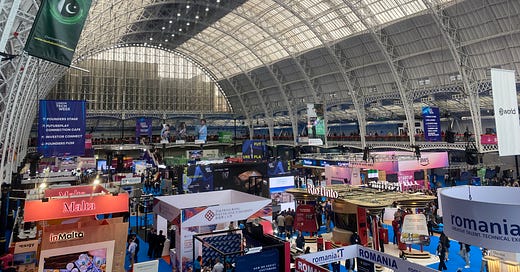London tech week: How we work is changing fast
At London tech week this week, my main takeaway was the pace of change for workforce, regardless of industry. AI solutions are taking on work that has historically been done by humans, increasingly independently so. The human workforce is experiencing role change and organisational restructuring as a result. Here are some exciting angles on AI at work that I came across.
1. AI as an Equaliser
Nvidia CEO Jensen Huang made an important point in his conversation with UK Prime Minister Keir Starmer:
The ability to instruct AI in natural language fundamentally lowers the barrier to technology.
It is easier to work with AI in natural language than with software with coding languages, or even technical tools with more accessible user interfaces. AI has the potential to democratise technological efficiency as well as creation and innovation. Organisations should leverage this, giving their human workforce opportunities to work with AI from the outset. I heard from Anthropic’s Head of UK, Ryan O'Holleran on how building something using AI is part of onboarding for all new hires, regardless of the employee’s starting skill base.
2. The Evolution of Roles is Inevitable
Connected to this, organisations need to proactively shape how humans and AI work together. That means getting cross-functional teams: operations, HR, finance and customer support to be active in implementing strategic goals on how AI tools are used, not just leaving this to IT departments. AI is not a siloed tech overhead, it becoming a mainstream workforce capability. The CEO of agentic AI platform Writer described how she has seen the most effective AI agent adoption for enterprise where organisations pair business executives across their organisation with IT talent. Going forward, every department has to be an IT department. To some extent, every organisation has to be a technology business. Clothing company American Eagle’s Marketing Executive recently spoke about navigating the paradox of using AI…to sell jeans. Forget technology budgets, roughly 50% of global GDP is labour spend. This money will increasingly be spent on AI agents.
3. From Human-First to Agent-First Workforces
Microsoft shared a vision of workforce transformation:
Stage 1: Human-first workforce
Stage 2: Humans guiding agents
Stage 3: Agents working alongside humans
Stage 4: Agent-first environments with human oversight
This progression reframes what it means to “work” in an AI-enabled organisation. Most of us are currently micromanaging the AI that we use. Over the next few years, we will move to supervising AI systems that complete end to end tasks and operate at scale. Teams will change, roles and responsibilities will change and workplace relationships, both human to human and human to AI, will also change.
Lara’s take
Agentic AI systems capable of acting autonomously toward defined goals with minimal human supervision are already being deployed across a growing number of organisations. AI-first startups are showing what's possible: some have dramatically reduced headcount, operating at scale with lean teams of 10% of what you’d expect. There's even talk of single-person unicorns on the horizon.
For established organisations, the path looks different. Integrating AI into existing structures requires careful realignment of roles, systems, and culture. Human talent will always be relevant. But the nature of that value, and what humans are expected to do to keep pace with the evolution of their work as they can handover more to technology, is shifting. Organisations, and the humans within them need to be active in shaping how this expanding technology works for their mission, people and end users. This can’t be done from the sidelines. Every team member has to be an active stakeholder at minimum, ambassador at best, in how AI is used in their work.






